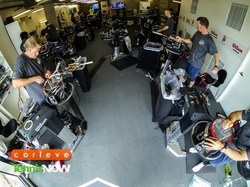HERE ARE SOME ARTICLES WE HOPE YOU FIND INTERESTING:

UNSTRUNG HEROES - THE STRINGERS AT THE AUSTRALIAN OPEN
MELBOURNE, Australia -- Take one step into the Wilson stringing room at the Australian Open and you can sense the buzz. This little room, lined wall to wall with stringing machine hardware, is a hub of activity during the first major of the year. Coaches and racquet runners visit the front desk by the minute, hauling two, three, sometimes four frames for stringing.
The average tennis player restrings a racquet when his or her strings break. Depending on one’s level of play, that may only be a few times per year. But professionals are a different story. Rarely, if ever, do they wait for a string to break on its own. Instead, most players on tour restring before every match. Joel Disbro oversees all of the action in the Wilson stringing room and knows firsthand just how crazy things can get.
“Monday was our busiest day, and [we strung] 416,” he said. “But as players go home, there are obviously less and less racquets.”
Each of the 13 stringers Wilson has employed for the Australian Open has been through a rigorous multi-day tryout process where they are evaluated on things like speed and accuracy.
“It’s very rigorous,” Disbro explained. “A lot of them don’t make it.”
Todd Mobley passed Wilson’s test and has been stringing on the pro tour for 25 years.
“I’ve strung for pretty much everybody but Roger Federer,” Mobley said wistfully. “One time I was assigned to him early at the US Open, but he never brought up a racquet.”
Of course, that doesn’t mean Federer failed to restring his racquets during the tournament. On the contrary, he has is own personal stringer who had not yet arrived on site. Mobley’s tiny window of opportunity closed quickly.
Players not fortunate enough (read: wealthy enough) to hire a full-time stringer of their own often cultivate relationships with the stringers at a given tournament site. Wilson employs people from all over the world – an advantage when the athletes want to talk tension and other racquet specifics in their native language.
Even without paying up for a personal stringer, players can still rack up a staggering stringing bill. At $32 per racquet ($28.61 USD) – not including string – the best competitors might shell out a cool $2,000 by the end of a Grand Slam. So what does that mean for lower-ranked players who aren’t raking in the big bucks?
“Yeah, they tend not to restring as often,” Disbro said matter-of-factly.
Tour players primarily use polyester string - a thick, durable variety that has helped them increase spin production as it has evolved. For stringers, the overwhelming shift to polyester has left some sore fingers in its wake; it is stiff and difficult to work with. When asked which string he prefers, Mobley smiled. “The softest string I can find. Natural gut is good.”
Natural gut, made from cow intestines and known for its unsurpassed feel, is the Rolls Royce of the string world, running the average consumer around $50 per set. It was the string of choice for many pros before polyester came along, but with current players more concerned with spin and power than touch and control, gut has become less appealing. Today it is most commonly used in hybrid combinations where one variety is used in the main (vertical) strings and another is used in the cross (horizontal) strings.
Each day Mobley and his colleagues will string anywhere between 22 and 32 racquets, but often frames arrive with a “rush” request attached. It’s not uncommon for players to restring in the middle of a match, meaning stringers have about 15 minutes to get the job done. Sometimes players want a fresh set – the extreme Australian heat means strings lose tension more quickly. Or, they may want to change things up completely.
“This year, we’ve had a couple of guys experiment with different strings while they are on the court playing a match, something totally different,” Mobley said. “I’ve never ever seen that happen. When you go on the court, you want to know what you’re playing with. I’m like, ‘Are you sure?’”
By the time gates close on the 2014 Australian Open, the Wilson stringing room will have worked through approximately 4,000 racquets. Not bad for two weeks’ work. Players will round up their personal racquet piles, the Wilson crew will pack up its stringing machines, and they will head off to their next destination to do it all again.
Reprinted from TennisNow - article by Blair Henley, Jan. 16, 2014
MELBOURNE, Australia -- Take one step into the Wilson stringing room at the Australian Open and you can sense the buzz. This little room, lined wall to wall with stringing machine hardware, is a hub of activity during the first major of the year. Coaches and racquet runners visit the front desk by the minute, hauling two, three, sometimes four frames for stringing.
The average tennis player restrings a racquet when his or her strings break. Depending on one’s level of play, that may only be a few times per year. But professionals are a different story. Rarely, if ever, do they wait for a string to break on its own. Instead, most players on tour restring before every match. Joel Disbro oversees all of the action in the Wilson stringing room and knows firsthand just how crazy things can get.
“Monday was our busiest day, and [we strung] 416,” he said. “But as players go home, there are obviously less and less racquets.”
Each of the 13 stringers Wilson has employed for the Australian Open has been through a rigorous multi-day tryout process where they are evaluated on things like speed and accuracy.
“It’s very rigorous,” Disbro explained. “A lot of them don’t make it.”
Todd Mobley passed Wilson’s test and has been stringing on the pro tour for 25 years.
“I’ve strung for pretty much everybody but Roger Federer,” Mobley said wistfully. “One time I was assigned to him early at the US Open, but he never brought up a racquet.”
Of course, that doesn’t mean Federer failed to restring his racquets during the tournament. On the contrary, he has is own personal stringer who had not yet arrived on site. Mobley’s tiny window of opportunity closed quickly.
Players not fortunate enough (read: wealthy enough) to hire a full-time stringer of their own often cultivate relationships with the stringers at a given tournament site. Wilson employs people from all over the world – an advantage when the athletes want to talk tension and other racquet specifics in their native language.
Even without paying up for a personal stringer, players can still rack up a staggering stringing bill. At $32 per racquet ($28.61 USD) – not including string – the best competitors might shell out a cool $2,000 by the end of a Grand Slam. So what does that mean for lower-ranked players who aren’t raking in the big bucks?
“Yeah, they tend not to restring as often,” Disbro said matter-of-factly.
Tour players primarily use polyester string - a thick, durable variety that has helped them increase spin production as it has evolved. For stringers, the overwhelming shift to polyester has left some sore fingers in its wake; it is stiff and difficult to work with. When asked which string he prefers, Mobley smiled. “The softest string I can find. Natural gut is good.”
Natural gut, made from cow intestines and known for its unsurpassed feel, is the Rolls Royce of the string world, running the average consumer around $50 per set. It was the string of choice for many pros before polyester came along, but with current players more concerned with spin and power than touch and control, gut has become less appealing. Today it is most commonly used in hybrid combinations where one variety is used in the main (vertical) strings and another is used in the cross (horizontal) strings.
Each day Mobley and his colleagues will string anywhere between 22 and 32 racquets, but often frames arrive with a “rush” request attached. It’s not uncommon for players to restring in the middle of a match, meaning stringers have about 15 minutes to get the job done. Sometimes players want a fresh set – the extreme Australian heat means strings lose tension more quickly. Or, they may want to change things up completely.
“This year, we’ve had a couple of guys experiment with different strings while they are on the court playing a match, something totally different,” Mobley said. “I’ve never ever seen that happen. When you go on the court, you want to know what you’re playing with. I’m like, ‘Are you sure?’”
By the time gates close on the 2014 Australian Open, the Wilson stringing room will have worked through approximately 4,000 racquets. Not bad for two weeks’ work. Players will round up their personal racquet piles, the Wilson crew will pack up its stringing machines, and they will head off to their next destination to do it all again.
Reprinted from TennisNow - article by Blair Henley, Jan. 16, 2014
